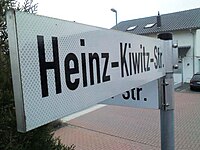Heinz Kiwitz
| Heinz Kiwitz | |
|---|---|

Sign for street named after Heinz Kiwitz
|
|
| Born | September 4, 1910 Duisburg, Germany |
| Died | 1938 Spain |
| Nationality | German |
| Education | Folkwangschule |
| Known for | woodcut illustration |
| Movement | German Expressionism |
| Website | www |
Heinz Kiwitz (September 4, 1910 – 1938) was a German artist. His woodcuts were in the German Expressionist style. An anti-fascist, he was arrested following the Nazis' seizure of power. He survived imprisonment in Kemna and Börgermoor concentration camps and was released in 1934. He went into exile in 1937, first living in Denmark, then in France, where he again began to fight Nazism. In 1938, he went to Spain to fight in the Spanish Civil War, where he apparently perished.
Kiwitz was born the son of a book printer and was exposed to the graphic arts from an early age. He had an older sister, Änne, and a younger sister, Gertrude, called Trudel. From early on, he loved to draw, but was not good in math. At the age of 10, he drew his older sister's art assignments and she received top grades. When he was 17 and stood 1.92 meters (6.3 ft), he joined a boxing club and trained at home, causing the furniture to shake when he jumped rope inside.
In 1927, he began studying art with Karl Rössing at the Folkwang University of the Arts in Essen. His long-time friend, Günther Strupp also attended the school and was a student of Rössing's. He was a member of the Association of Revolutionary Visual Artists during this period.
In art school, he preferred to create wood engravings, but after finishing, Kiwitz began working more with woodcuts, which entailed a process more suited to his temperament. He and Strupp went to Cologne for a few months and later, he went to Berlin to pursue work and further study. In April 1932, his woodcut illustrations for a satirical poem by Erich Weinert were published along with the poem in Magazin für Alle. He also made a woodcut decrying the Nazi book burnings and one that features caricatures of Hitler, Goebbels and Göring (see illustration). In early 1933, after the Nazis seized power, Kiwitz' studio was ransacked by the Sturmabteilung (SA) and he left Berlin, returning to his parents' home. He also visited his girlfriend, who as a Communist and political enemy of the Nazis, had been arrested and thrown in prison.
...
Wikipedia
